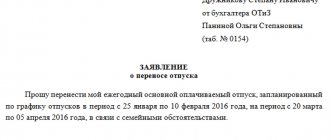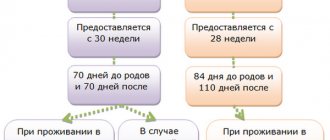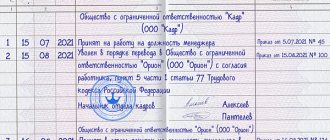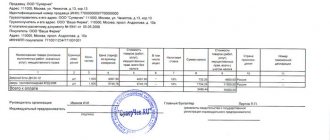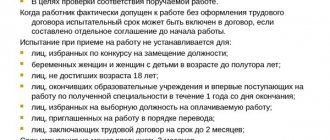How to go on another vacation and quit immediately after it: Art. 127 Labor Code of the Russian Federation
Vacation followed by dismissal is a phrase used in labor legislation as a separate concept.
IMPORTANT! In accordance with Art. 127 of the Labor Code of the Russian Federation, an employee has the right to leave before dismissal (except for dismissal for guilty actions).
This double maneuver by the employee entails additional steps for the employer to formalize and implement it. Each component of the furlough-furlough scheme requires compliance with legal requirements.
For example, dismissal is a whole complex of events, the initial step of which is the employee writing a statement. It launches a mechanism for interaction between management, personnel officers, accountants and other specialists of the company. Each of the listed “cogs” of the internal company apparatus performs its own function, the result of which will be the dismissal of the employee, formalized in accordance with the law.
At the same time, the interests of both parties to the terminated employment contract should not be affected - the employee will receive the money due to him, and the employer will fulfill the functions assigned to him in complying with the dismissal procedure.
“Unified Form No. T-8 - form and sample of completion” will help you fill out an order in connection with the termination of an employment relationship .
No less important in terms of compliance with legally established procedures is the process of an employee going on leave.
This material will help you understand the specifics of issuing a “vacation” order. .
And combining these events into one requires an even more careful and scrupulous approach, since it contains a number of mandatory legal requirements.
ConsultantPlus experts explained whether it is possible to provide a worker with leave at his own expense followed by dismissal. Get free trial access to the system and move on to the Ready-made solution.
Conditions for granting study leave
In accordance with Ch. 26 of the Labor Code of the Russian Federation, the employer is obliged to provide persons combining work with education with additional educational leave. This obligation arises regardless of whether the employee himself expressed a desire to study or whether he was sent for training by the employer.
Vacations can be either paid or unpaid - this is influenced by the employee’s form of education (full-time, part-time or part-time). Basically, if an employee is studying full-time, the leave is not paid, but if it is part-time or part-time, it is paid.
However, the employer does not have the obligation to provide study leave to all students studying without exception, since the legislator has established certain conditions for this.
At the same time, study leave is granted not only to employees who are receiving education for the first time, but also to those who already have a professional education at the appropriate level and who are sent to receive education by the employer under an employment or student agreement concluded in writing (Part 1 of Article 177 of the Labor Code of the Russian Federation).
Guarantees and compensations for employees receiving education at the appropriate level not for the first time and on their own initiative, as well as those studying in programs that do not have state accreditation, may be established by a collective or labor agreement.
A successful student is considered to be one who has no debt for the previous course (semester), which is confirmed by a summons certificate, without the presentation of which by the employee the employer is not obliged to provide study leave.
If an employee receives education simultaneously in two organizations carrying out educational activities, study leave is granted only in connection with receiving education in one of these organizations (at the employee’s choice).
Is the employer obliged to provide part-time employees with study leave or annual paid leave during the study period?
Guarantees and compensation for employees combining work with education are provided only at their main place of work ( Article 287 of the Labor Code of the Russian Federation ).
According to Part 1 of Art. 286 of the Labor Code of the Russian Federation, persons working part-time are granted annual paid leave simultaneously with leave for their main job. If an employee has not worked at a part-time job for 6 months, leave is provided in advance. That is, the employer for whom the employee works part-time is obliged to provide him only with annual paid leave simultaneously with leave at his main place of work. The Labor Code does not provide for granting part-time workers study leave or annual paid leave simultaneously with study leave for their main job.
Thus, in a part-time job, you can contact the employer with a copy of the summons certificate and a request only for leave without pay for the duration of the study leave. And if the employer does not object, the part-time worker will take leave at his own expense during the training, the duration of which is determined by agreement between the employer and the employee.
Application - the starting point for registration
The set of measures to formalize the “vacation-dismissal” procedure begins with an application from the employee. The employee writes it in his own hand in a generally accepted form addressed to the head of the company, indicating his position and surname. There is no special form for such a statement, and there are no restrictions on its volume and content.
Since a double event is planned (vacation - dismissal), there can also be 2 applications. The first will contain a request for leave with a special clause regarding its duration and starting date. The second statement will contain a written desire to sever the employment relationship with the employer.
There is no restriction on the number of statements in the law, so it is possible that the employee will combine the texts of both statements into one document.
If an employee decides to leave immediately after the vacation due to him according to the approved vacation schedule, then a separate application for vacation does not need to be written, since the schedule is already the basis for receiving vacation.
Applications can be found on our website using the link below:
Example
Timofeev N.L., an auxiliary worker in the mechanical section, decided to quit, having previously taken his legally earned regular vacation. He considered fiddling with individual applications to be an unnecessary waste of time and effort, so he expressed his will in one phrase: “I ask you to allow me to go on vacation from April 16, 2022 for 28 calendar days, followed by dismissal of my own free will.”
We will tell you how to apply for leave followed by dismissal in the following sections.
Base
According to legal norms, the basis for issuing an order will be a written statement from the employee. In it, he addresses the employer with a request for leave and dismissal.
It is important to understand that a leave application is just that: a request. Whether to satisfy her or not depends on the employer. If there is no desire, then he has the right not to provide the employee with leave before dismissal. This is stated in the ruling of the Constitutional Court No. 29-0 of February 5, 2004.
This nuance applies to all those cases (and there are the vast majority of them) if such a possibility was not spelled out in advance in the employment contract. It does not exist in standard versions of the agreement.
Since the application is free-form, the employee can write either one general application or two different ones. Any number of applications can be attached to an order for leave followed by dismissal. This will not make them lose their legal force. Naturally, provided that they are compiled without violations.
We respect rights and take into account restrictions
In order for the procedure for going on leave with subsequent dismissal to be carried out within the framework of labor legislation, the employer and employee must not forget about their rights, responsibilities and restrictions.
Example (continued)
Timofeev N.L., an auxiliary worker at the mechanical section, was refused his desire to go on vacation before his dismissal, and his attempts to complain to the labor inspectorate about his employer were unsuccessful. In this situation, the employer’s consent or refusal is his right, not his obligation, in accordance with the determination of the Constitutional Court of the Russian Federation dated 02/05/2004 No. 29-O.
If the director of the company changes his mind and allows Timofeev N.L. to go on vacation before resigning, Timofeev N.L. has a chance to change his mind and not sever the employment relationship.
There is one exception to this rule: it will not be possible to refuse leave before dismissal if a clause on the provision of leave before dismissal is present in the agreement between the employee and the company (employment contract).
Legislation allows an employee to express his desire to return to his workplace after a vacation, but there is a time limit for such a step: he can change his mind only before going on vacation (letter of Rostrud dated December 24, 2007 No. 5277-6-1, ruling of the Constitutional Court dated January 25 .2007 No. 131-О-О).
The next point that requires attention is the legal ban on the “vacation-dismissal” event for a certain category of employees.
Example (continued)
A colleague of the auxiliary worker Timofeev N.L., a truant and rowdy mechanic Gulyaev I.T., who was dismissed under an article for malicious violation of labor discipline, decided, following the example of his friend, to write an application for leave with subsequent dismissal. But the employer refused. According to Art. 127 of the Labor Code of the Russian Federation, malicious violators of labor discipline and those dismissed for this reason do not have the right to leave before dismissal.
The above legislative nuances must be taken into account by both the employee (before writing an application) and the employer (when considering this application).
What information is included in the document?
There is no unified form of this document. You can use the company letterhead. Most importantly, an application for dismissal while on vacation must be in writing; this requirement is enshrined in the Labor Code of the Russian Federation.
It contains the following information:
- in the header in the dative case the name of the employing organization, position and full name of the manager are indicated;
- in the genitive case, the full name and position of the resigning employee;
- Title of the document;
- wording containing a request to terminate the contract at the request of the employee;
- date of contract termination;
- date of compilation, signature of the employee.
Date of dismissal after vacation: an important aspect
In a “vacation-dismissal” situation, the dates of the last working day and dismissal do not coincide.
In accordance with Art. 84.1 of the Labor Code of the Russian Federation, the day of dismissal (termination of an employment contract) is the last working day of an employee with a given employer. This is the general approach. However, in the situation of going on vacation with subsequent dismissal, the date of dismissal is considered the last day of vacation (Article 127 of the Labor Code of the Russian Federation). And the last working day is the last day the employee goes to work (determination of the Constitutional Court of the Russian Federation dated January 25, 2007 No. 131-О-О).
IMPORTANT! It is necessary to make a final settlement with the employee and issue a work book on the last day of his work before the vacation.
At the same time, from the norms of labor legislation described above, it follows that the dismissal in the work book and order is dated by the last day of the employee’s vacation.
The date of dismissal (as well as the vacation itself) are not postponed if the employee who went on vacation gets sick. The employer has no obligation to extend the rest period for the employee's sick days, despite the general rule prescribed in Art. 124 of the Labor Code of the Russian Federation, since with the start of vacation the employment relationship is considered severed (letter of Rostrud dated December 24, 2007 No. 5277-6-1).
Registration of dismissal
The Labor Code does not establish a specific procedure for granting leave followed by dismissal.
Article 127 only states that such leave is granted on the basis of a written application by the employee and that the day of dismissal is considered the last day of leave. And in Letter No. 5277-6-1, Rostrud noted that all settlements with the employee are made before going on vacation, since after its expiration the parties will no longer be bound by obligations. The same should be done with the work book and other work-related documents that the employer is obliged to provide to the employee - they must be given to him before going on vacation, on the last day of work. And in fact, the employment relationship ends from the moment the vacation begins.
Thus, the employer must first receive a leave application from the employee followed by dismissal. Many experts advise employees to write two applications: separately for leave with subsequent dismissal and separately for dismissal, in particular when the employee resigns of his own free will. We believe that one application is sufficient, only it must contain a request for leave with subsequent dismissal and indicate the reason for such dismissal.
Here are sample statements.
| To the director of municipal educational institution secondary school No. 25 I. I. Ivanov from a math teacher P. P. Petrova Statement I propose to terminate the employment contract dated 02/03/2012 No. 03/12-TD on the basis of Art. 78 of the Labor Code of the Russian Federation by agreement of the parties 09/05/2016. I ask you to provide me with annual paid leave from August 23, 2016, lasting 14 calendar days, followed by dismissal. Please indicate the condition for granting me leave in the agreement on termination of the employment contract. Petrov 07/30/2016 |
Or:
| To the director of municipal educational institution secondary school No. 25 I. I. Ivanov from a math teacher P. P. Petrova Statement I ask you to provide me with annual paid leave from August 23, 2016, lasting 14 calendar days, followed by dismissal at my own request. Petrov 07/30/2016 |
But as for orders, their employer must issue two:
- on the provision of leave according to the unified form T-6, approved by Resolution of the State Statistics Committee of the Russian Federation dated January 5, 2004 No. 1;
- about dismissal according to the unified form T-8.
The basis will be the same statement (if the employee wrote more than two statements).
The employee’s orders must be familiarized with signature; if he refuses to familiarize himself, a corresponding act is drawn up. On the last day of work before the vacation, the employee must be given all the necessary documents (including a work book) and all payments must be made. Regarding the payment of vacation pay, special rules for vacation followed by dismissal have not been established; one remains to be guided by the general norms of the Labor Code. So, according to Art. 136 payment for vacation must be made no later than three days before it starts.
note
When granting leave with subsequent dismissal upon termination of the employment contract at the initiative of the employee, he has the right to withdraw his resignation letter. But he can do this only before the day the vacation begins and if another employee is not invited to take his place by way of transfer (Part 4 of Article 127 of the Labor Code of the Russian Federation). If an employee received “vacation pay” and then withdrew his application, then the employer, in accordance with Art. 137 of the Labor Code of the Russian Federation, before the end of the working year, for which the employee has already received annual paid leave, has the right to make deductions from his salary to pay off his debt for unworked vacation days.
Upon receipt of the work book, the employee must sign in the book for recording the movement of work books and inserts in them (clause 41 of the Decree of the Government of the Russian Federation of April 16, 2003 No. 225 “On work books”). The entry on termination of the employment contract is certified by the signature of the employee responsible for maintaining work records, the seal of the employer and the signature of the person being dismissed.
An entry in the work book about the basis and reason for termination of the employment contract must be made in strict accordance with the wording of the Labor Code of the Russian Federation or other federal law and with reference to the article, part of the article, paragraph of the article of the Labor Code of the Russian Federation or other federal law (Part 5 of Article 84.1 of the Labor Code RF). Do not forget that the day of dismissal will be the last day of vacation.
For example, if the basis for dismissal was an agreement of the parties (clause 1, part 1, article 77 of the Labor Code of the Russian Federation), the entry will look like this.
| 10 | 15 | 08 | 2016 | Employment contract terminated | Order dated 01.08.2016 |
| by agreement of the parties, paragraph 1 | No. 24 | ||||
| part one of article 77 of the Labor Code | |||||
| Code of the Russian Federation. |
The entry about the employee’s dismissal entered in the work book is repeated in his personal card.
Choosing the form of an order for leave with subsequent dismissal
Taking into account the above, having received an application from the employee, the employer will have to issue an order - a local internal act related to the “vacation - dismissal” procedure (Article 84.1 of the Labor Code of the Russian Federation). He also has the right to choose: to order leave and dismissal in one document or to issue 2 orders separately for each part of the “vacation-dismissal” event.
With the first registration option, it will be necessary to issue an order in a independently developed form and provide for the entire scheme in full: granting leave and subsequent termination of the employment contract.
The second option will not require unnecessary actions from the employer - it is enough to fill out the usual unified forms of “vacation” order (T-6, T-6a) and “dismissal” (T-8, T-8a).
IMPORTANT! The formats of documents used by the company (both unified and created in-house) must be approved by the manager and developed taking into account the recommendations of GOST R 15489-1-2007 “Document Management”.
For information on mandatory personnel documents and personnel records, see the material “Personnel documents that must be in the organization .
Sample order for leave with subsequent dismissal at will
Dismissal after vacation is formalized by an order containing 3 main components: introductory part, main text and final elements.
The introductory part of the order contains 2 names: the name of the company (this attribute is required for any internal document) and the title of the order. It may sound like this: “On granting leave with subsequent dismissal.”
The listed elements are supplemented by the order number and its date.
The main text of this document should reflect all the necessary components of the “vacation-dismissal” procedure. Namely: order the provision of leave to the employee (indicating its starting date and duration) and provide for the termination of the employment contract after its end (indicating the details of the contract itself and the date of dismissal).
An integral element of the main text of the order is the instruction from the management to the involved services (HR and accounting) to pay the employee and take care of issuing him a set of “dismissal” papers.
The material “Unified Form No. TD-1 - Employment Contract” .
An example of the design of the main part of the text of an order regulating the stages of dismissal after voluntary leave:
1. Provide mechanic Khusnutdinov P.N. with leave followed by dismissal from November 3 to November 30, 2022, lasting 28 calendar days.
2. Terminate the employment contract dated February 12, 2018 No. 134 with Khusnutdinov P.N. on the basis of clause 3 of Art. 77 Labor Code of the Russian Federation. The day of dismissal is considered to be November 30, 2021.
3. The head of the financial and accounting group, Kamaletdinova R.R., make the final settlement with Khusnutdinov P.N.
4. The head of the personnel department, Aidarov N.G., issue Khusnutdinov P.N. with a work book and other documents provided for by labor legislation, 12/01/2021.
ATTENTION! If you keep work books in electronic form, upon dismissal the employee must be given an electronic version of his work record in the STD-R form. How to fill out the form correctly, see here.
The final elements of the order are a reference to the basis for its execution (Articles 77, 84.1, 127 of the Labor Code of the Russian Federation, personal statement of the employee, etc.) and the signature of the head of the company. An employee going on vacation with subsequent dismissal is familiarized with the order, which he also signs.
How to make an entry in the work book if an employee is granted leave with subsequent dismissal? Find out the answer to this and other questions by getting a free trial access to the ConsultantPlus system.
Procedure for granting study leave
As already noted, the basis for study leave, provided all other conditions are met, is a summons certificate issued to the employee by the educational institution. The form of the summons certificate, which gives the right to provide guarantees and compensation to persons combining work with education, is approved by Order of the Ministry of Education and Science of the Russian Federation dated December 19, 2013 No. 1368. Simultaneously with the certificate, employers, as a rule, request an application from the employee requesting study leave.
The application is not a mandatory document under the law and its absence should not be grounds for denying an employee leave.
The deadline for the employee to submit a summons certificate is not established, so the employee can submit it at any time, even on the eve of study leave.
Based on the summons certificate (and application), the employer issues an order to provide additional leave, which can be issued using the unified form T-6, approved by Resolution of the State Statistics Committee of the Russian Federation dated January 5, 2004 No. 1 . The order indicates what type of additional (study) leave is provided: with or without maintaining average earnings. The employee must be familiar with the order upon signature.
Can an employer, based on an employee’s request, provide study leave of shorter duration than indicated in the summons certificate?
Rostrud in 697‑6‑1 dated 09/12/2013 on this issue stated that since leaves granted in connection with on-the-job training in educational institutions of higher vocational education have a strictly intended purpose, they should be used only during established periods. deadlines. Officials believe that granting study leave of a shorter duration than indicated in the summons certificate, even if the employee requests it, does not fully comply with the requirements of current legislation.
However, many experts believe that if the employee indicates a smaller number of days in the application, then he can be given a leave of shorter duration, since there is no prohibition on this by law.
Information about additional leaves is also entered into the employee’s personal card.
In the working time sheet, the time of study leave with pay is marked with the letter code “U” or the number “11”, without pay – with the letter “UD” or the number “13”.
When the employee returns from study leave, he must provide the employer with a detachable part of the certificate.
By agreement between the employer and the employee, annual paid leave may be added to the study leave (Part 2 of Article 177 of the Labor Code of the Russian Federation).
Please note that for employees admitted to apply for the academic degree of Candidate of Sciences or Doctor of Science, a separate procedure has been established for obtaining study leave - see Rules for granting leave to persons admitted to apply for the academic degree of Candidate of Sciences or Doctor of Science , approved by the Decree of the Government of the Russian Federation dated 05/05/2014 No. 409 .
Unlike other educational leaves, an applicant for the academic degree of Candidate of Sciences or Doctor of Sciences must notify the employer in writing of his intention to exercise his right to leave no later than one year before the expected start date of the leave.
Is it possible to provide an employee with study leave followed by dismissal in accordance with Art. 127 Labor Code of the Russian Federation?
Due to the fact that the Labor Code contains norms that do not specify what kind of leave is meant, the question arises: does this include study leave (similar problems arise with leave without wages)? The issue is controversial, but in practice, study leave followed by dismissal is used.
However, in Art. 127 of the Labor Code of the Russian Federation states that upon dismissal, an employee may be given all unused vacations. Here we are clearly not talking about study leave, but about annual basic and additional leave. Therefore, the provisions of Art. 127 do not apply to study leave.
Moreover, a student employee has the right to terminate an employment contract at his own request by notifying the employer in writing no later than 2 weeks in advance, unless a different period is established by law. The period begins the next day after the employer receives the employee’s application for dismissal ( Part 1 of Article 80 of the Labor Code of the Russian Federation ).
Is it possible, at the initiative of the employer, to dismiss an employee while he is on study leave?
But in this case, we believe that the provision of Part 6 of Art. 81 of the Labor Code of the Russian Federation , according to which the dismissal of an employee at the initiative of the employer is not allowed (except in the case of liquidation of an organization or termination of activities by an individual entrepreneur) during periods of temporary disability and while on leave, also applies to study leave. Therefore, if, for example, they want to dismiss an employee due to a reduction in the number or staff, notifying him 2 months in advance, and the date of his dismissal falls during study leave, then it is impossible to terminate the employment contract on the same day. An employee must be fired on the first day after returning from vacation.
An employee with whom a fixed-term employment contract was concluded for the duration of the duties of the absent employee brought a summons certificate a few days before the latter went to work. Should we give him study leave and for how many days?
There are several opinions on this issue.
Some people think that an employee should be fired on the day the main employee leaves due to Part 3 of Art. 79 of the Labor Code of the Russian Federation , but provide study leave and pay for it in full. This conclusion, in particular, was made in the Determination of the Leningrad Regional Court dated 08/06/2015 No. 33-3731/2015 .
The second position: it is necessary to extend the fixed-term employment contract with the employee for the duration of the study leave, and pay him on the last working day, that is, by analogy with Art. 127 of the Labor Code of the Russian Federation when granting an employee leave with subsequent dismissal.
However, we adhere to the third position: if the date of departure of the main employee is known, the employment contract is terminated upon his return to work, since study leave is not a basis for extending a fixed-term contract. And study leave must be granted and paid only within the validity period of a fixed-term employment contract.
Providing leave with subsequent dismissal: the stage of processing payments
An integral part of the “vacation-dismissal” event is the settlement stage. Since the employee not only goes on vacation, but also quits immediately, it is necessary to take into account both types of payments: those related to both the vacation and the final payment.
The executed order, which was described in the previous sections, serves as the basis for issuing a settlement note. If a company has established by its internal local act the use of unified forms in its work, it will have to complete 2 calculations:
- T-60 “Note-calculation on granting leave to an employee” is filled in with information about the billing period and earnings for the specified period. The average daily earnings, calculated in accordance with the Government Decree on the procedure for calculating the average salary dated December 24, 2007 No. 922, is multiplied by the number of vacation days. As a result, the amount of vacation pay is formed.
The sample posted on our website in the material “Unified Form No. T-60 - Form and Sample” .
- T-61. “Note-calculation upon termination (termination) of an employment contract with an employee (dismissal)” is drawn up as follows:
- on the front side of the form information about the employee (full name, position) and details of the dismissal order are reflected, and a note is made that the employee did not take full leave or used it in advance;
- on the reverse side of the form, the billing period and earnings for the months of this period are indicated, then the average daily earnings are calculated and the amount of compensation for the part of the vacation not taken off.
IMPORTANT! Compensation is calculated taking into account the payments provided by the company - clause 2 of Resolution No. 922 contains their full list. In this case, individual payments listed in paragraph 5 of Resolution No. 922 are not taken into account.
For the completed version of Order T-61, see the material “Unified Form No. T-61 - Form and Sample” .
We will tell you more about how to calculate “vacation” compensation and in what cases you can do without this calculation in the following sections.
Payment for study leave
So, while the employee is on study leave, he is paid the average salary. Its calculation is made in accordance with Art. 139 of the Labor Code of the Russian Federation and the Regulations on the specifics of the procedure for calculating average wages , approved by Decree of the Government of the Russian Federation of December 24, 2007 No. 922 (hereinafter referred to as Regulation No. 922 ).
The average salary accrued to an employee during study leave must be paid 3 calendar days before its start (Article 136 of the Labor Code of the Russian Federation, Letter of Rostrud dated July 30, 2014 No. 1693-6-1).
The average daily earnings for vacation pay are calculated for the last 12 calendar months (calculation period) ( clause 4 of Regulation No. 922 ). In this case, the average daily earnings to pay for vacations provided in calendar days are calculated by dividing the amount of wages actually accrued for the billing period by 12 and the average monthly number of calendar days (29.3) ( clause 10 of Regulation No. 922 ).
The amount of vacation pay due to the employee is determined by multiplying the average daily earnings by the number of calendar days in the period subject to payment (that is, by the number of calendar days of study leave) ( clause 9 of Regulation No. 922 ).
By virtue of clause 14 of Regulation No. 922 , when determining average earnings for payment of additional educational leaves, all calendar days (including non-working holidays) falling during the period of such leaves provided in accordance with the educational institution’s certificate are subject to payment.
For example, if a study vacation coincides with the New Year holidays, the employee will retain his average earnings for these holidays.
If an employee falls ill during study leave, temporary disability benefits will not be paid to him, regardless of whether he retained average or partial earnings during study leave or not[1].
If an employee passes his exams ahead of schedule, is it possible to deduct from him the amount of average earnings for the remaining vacation period?
Since the study leave was already paid according to average earnings before it began, and the Labor Code does not allow withholding this amount or part of it upon dismissal of a person working under a fixed-term employment contract due to the expiration of this contract, the employer does not have the right to withhold this amount at final settlement.
There is also no legal basis for withholding previously paid vacation pay upon expulsion from an educational institution until the end of study leave. Based on Art. 137 of the Labor Code of the Russian Federation, deductions from an employee’s salary are made only in cases provided for by the Labor Code of the Russian Federation and other federal laws.
Calculation of vacation compensation
In a situation where an employee goes on vacation and is subsequently fired, compensation for unpaid vacation days is not always calculated. There is no need for calculation if the employee has taken all vacation periods in full.
However, often workers are not allowed to fully rest due to production needs, or the reduced vacation is due to the desire of the employee himself. Then, before dismissal, the employer needs to calculate and pay “vacation” compensation. Its value depends on the number of unused vacation days and average daily earnings.
For information on the specifics of calculating vacation days not taken off, see the material “How to calculate the number of vacation days upon dismissal?” .
The calculation of “vacation” compensation is made not only by the number of vacation days not taken in the current year, but also taking into account the duration of all vacations not used by the date of dismissal. For example, for the last 3 years, an employee has only had 14 of the required 28 days of rest, but this year he earned 20 days of vacation, of which he used only half. By summing up the indicated non-vacation days, we get the number 52 (14 × 3 + 20 / 2) - it must be multiplied by the average daily earnings to determine the amount of “vacation” compensation.
Read more about calculating compensation for unused vacation here .
Composition of the order
The order has three parts:
- introduction;
- paper body;
- conclusion.
The introduction indicates the name of the organization, its basic details: order number, its date and city of signing.
The most difficult thing is the formulation of the main part. Each organization will have its own nuances. That is why the order for leave with subsequent dismissal is drawn up in free form.
But free form does not mean that you need to write an order without being guided by certain norms. If at least one fundamentally important detail is missed, then the order may not be liked by regulatory organizations.
There is another option: the employee will go to court and win it, since the documentation for his dismissal and vacation pay was completed incorrectly. Depending on the composition of the company and the specialists who are responsible for certain issues, the body of the order includes:
- A link to a statement (or two statements) from the employee himself.
- Information on the provision of annual paid leave. The start and end dates and the total number of days are indicated.
- Full name of the person being dismissed.
- Under what article of the Labor Code does dismissal occur?
- An important date is the day the vacation ends and the dismissal begins.
- An order from the accounting department to pay an employee. It is advisable to indicate the period within which the accountant is obliged to do this.
- Oblige the HR department to issue a work book and draw up documents related to dismissal.
- Who is responsible for carrying out the order: full name and position.
Important: the final calculation and issuance of the work permit must be made on the day the employee goes on vacation. At the end of the order, the signatures of the manager and the dismissed employee are placed, with their position, description and date.
Final settlement
In addition to determining the amount of “vacation” compensation, it is necessary to make a number of calculations and calculations. It all depends on the terms of the employment contract or agreement on its termination, as well as the presence in the company’s internal local acts of reference to compensation, severance pay or other “dismissal” payments.
First of all, you will need to calculate the salary for the days worked, and then make all the necessary deductions to obtain the final settlement amount issued to the employee in connection with his dismissal.
How to calculate salary upon dismissal, read here.
In addition, it is necessary to take into account that labor legislation protects the interests of the employee in a situation of dismissal, providing for the need to pay severance pay.
IMPORTANT! If an employee resigns due to the closure of a company or staff reduction, Art. 178 of the Labor Code of the Russian Federation obliges the employer to pay him severance pay in the amount of the average monthly salary. Find out how to calculate the amount of severance pay here . In addition, this article provides for cases of maintaining the employee’s average monthly earnings during the second (if he brings evidence that he is not yet employed) and third (by decision of the employment service) months after dismissal.
In some cases (for example, an employee is called up for military service), severance pay will have to be paid in the amount of two weeks' average earnings (Articles 77, 83, 178 of the Labor Code of the Russian Federation).
When making a final settlement with a resigning employee, it is necessary to take into account all benefits and compensations due to him (both under labor legislation and those provided for in the employment contract and internal company regulations).
Taking leave followed by dismissal: the final stage
Paying an employee is an important, but not the last step in the multi-stage “vacation - dismissal” event. Without additionally filling out the paperwork, it will not be possible to say goodbye to the employee.
The first important and mandatory document issued to any resigning employee (in addition to the work book), even if he did not ask for it, is a certificate of earnings for the two calendar years preceding the dismissal .
IMPORTANT! A certificate of earnings is issued to the employee in the form approved. by order of the Ministry of Labor dated April 30, 2013 No. 182n (Clause 3, Part 2, Article 4.1 of the Law “On Compulsory Social Insurance” dated December 29, 2006, No. 255-FZ). The procedure for filling out such a certificate can be found here.
Other mandatory documents to be issued to employees upon termination of employment are (Clause 4, Article 11 of the Law “On Personalized Accounting” dated 04/01/1996 No. 27-FZ):
- an extract from SZV-M for the month in which the employee quits;
- SZV-EXPERIENCE for the person resigning (for the year of dismissal);
- Section 3 of the unified calculation of insurance premiums for the quarter in which the employee is dismissed.
Usually, contacts with the resigning employee do not end there - the employee can contact the company’s specialists with a request to provide additional certificates and copies of documents. At the same time, the issuance of papers cannot be carried out uncontrolled according to the “asked and received” scheme. Communication between a resigning or already resigned employee and a former employer is based on an algorithm (Article 84.1 of the Labor Code of the Russian Federation).
This rule applies to the employee’s desire to obtain certificates (Article 62 of the Labor Code of the Russian Federation):
- on accrued and paid insurance pension contributions;
- period of work in this company;
- income in form 2-NDFL (the procedure for issuing it is described here ).
In addition to the specified papers, the employee has the right to request the necessary information about his transfers in the course of his work in this company, copies of orders for hiring and dismissal - the employer has no right to refuse this request. The employee is not obliged to pay money for the copies received (Article 62 of the Labor Code of the Russian Federation, letter of Rostrud dated December 20, 2012 No. PG/9518-6-1).
Results
The procedure for registering leave with subsequent dismissal is initiated by the employee’s application, followed by orders for leave and termination of the employment contract.
An integral stage of this event is the calculation of “vacation” compensation and other payments and deductions. The process is completed by issuing the resigning employee a set of documents (work book, certificates, etc.).
Sources: Labor Code of the Russian Federation
You can find more complete information on the topic in ConsultantPlus. Free trial access to the system for 2 days.
General dismissal
Let us remind you that the general procedure for dismissal at the initiative of an employee is prescribed in Art.
Labor Code of the Russian Federation (LC RF). The employee must notify the manager in writing of his intention two weeks in advance. The countdown begins from the moment the employer receives the application. The last day of work is the date specified by the employee. If there is no date on the application, then 14 calendar days after submission of the application. On the last day of work, the organization is obliged to issue the employee a work book and, upon written request, other documents related to the work, as well as pay him wages for the last days, compensation for unused vacation and other amounts due by law.
Contour.Personnel: convenient mechanisms for auto-filling orders for vacation, dismissal, hiring.
To learn more

